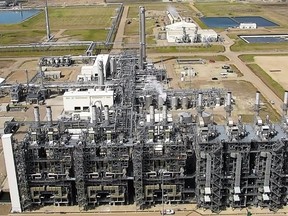
It’s taken some time to cross the finish line, but an $8.9-billion petrochemical megaproject in Alberta is about to move ahead, the first of what could be several major decarbonization developments that tap into federal and provincial incentive programs.
Michigan-based Dow Inc. said Tuesday it has given the green light to what it calls the world’s first net-zero integrated ethylene cracker and derivatives complex, to be built in Fort Saskatchewan near Edmonton.
The company, which first proposed the project in the fall of 2021, said its board of directors made a positive final investment decision (FID) on the US$6.5-billion development — a price tag that doesn’t include incentives from the provincial and federal government or related third-party investments worth another $2.7 billion.
Federal officials pegged the combined investment at more than $11.5 billion.
“It’s huge. It’s a great thing for Alberta, first and foremost, that it was selected over various other locations that Dow could build this facility at,” said Bill Rawlusyk, executive director of North American NGL markets with S&P Global Commodity Insights in Calgary.
“It’s great to have this kind of investment and a lot of parties really worked together to make this FID decision a reality . . . In terms of scale, it’s extremely large and definitely world scale.”
A news conference on the announcement was held in Fort Saskatchewan on Wednesday and included Dow CEO Jim Fitterling, Premier Danielle Smith and Deputy Prime Minister Chrystia Freeland.
“The project serves as a leading example that industrial decarbonization is both possible and profitable,” Fitterling said Tuesday in a news release.
Construction on the development, which will triple Dow’s ethylene and polyethylene capacity at its existing petrochemical complex in Fort Saskatchewan, is expected to start next year, with the development built in phases.
The project will create up to 7,000 jobs during the peak of construction, and 400 to 500 full-time positions once it’s operating.
It will include building a new ethylene cracker, and boosting its polyethylene production capacity by two million tonnes per annum.
The company said the extra capacity will let it capture high-value markets, including plastic packaging, infrastructure and hygiene items.
Dow says the project will convert the site’s cracker off-gas into hydrogen, used as a clean fuel in the ethylene production process. In addition, carbon dioxide emissions will be captured, transported and stored off-site.
The project will decarbonize about 20 per cent of its global ethylene capacity, while boosting its global polyethylene supply by 15 per cent.
The first phase is expected to begin operating in 2027, with a second phase coming online two years later.
Dow specifically cited “the Canadian and Alberta advantage” among the reasons that it will invest in the region.
Western Canada has large volumes of cheap natural gas feedstock, as well as cost-advantaged ethane.
The facility is expected to be one of Dow’s most cost-competitive in the world once it’s fully operational, the company stated in the release.
“The region also features access to existing CO2 transportation and storage infrastructure with available capacity to fully support decarbonization of the project,” it said.
Several large petrochemical, oil and gas, cement and power-generation projects have been proposed in Alberta over the past three years, as companies and the federal and provincial governments strive to reach net-zero emissions by 2050.
However, many have been waiting for the federal and provincial governments to unveil incentive programs to decarbonize, something that has happened in recent days — and could lead to more projects proceeding.
“This project will spur future investments in Alberta that will help turn the Alberta Industrial Heartland into a globally important industrial ecosystem,” said Energy Minister Brian Jean.

Ottawa announced last week it will finally introduce legislation on its investment tax credits for carbon capture, utilization and storage (CCUS) projects, worth up to 50 per cent of eligible capital expenses on equipment.
(The province confirmed Tuesday it will offer 12 per cent grants on new CCUS developments.)
Under the provincial government’s existing Alberta Petrochemicals Incentive Program (APIP), proponents already receive grants worth 12 per cent of a project’s eligible capital costs, once the development is operating.
It’s expected the province’s contribution to the Dow project will be about $1.2 billion, although it could reach $1.8 billion through future development phases, Premier Danielle Smith said Wednesday.
Federal incentives that are available through two investment tax credit programs are projected to be about $400 million.
Dow noted its Fort Saskatchewan project will be the first initiative to access the federal government’s new investment tax credit program, while it also credited the provincial government and Fort Saskatchewan for providing incentives.
“Our view on the Alberta project is we’re working in an environment that’s supportive of decarbonization. There’s a price on carbon in Canada. There’s existing carbon capture infrastructure,” Fitterling told analysts during a recent earnings call.
“And there’s obviously some investment credits for the hydrogen portion of the project. And so those are all positive.”
He said peak construction will take place between 2025 and 2026.
Shruthi Vangipuram, a senior research analyst with energy consultancy Wood Mackenzie, noted the demand for ethylene and polyethylene is expected to remain robust in the medium to long term.
The Alberta site provides Dow with access to cheap natural gas, and ethane supply in the region is projected to grow by more than 30 per cent over the next decade, according to Wood Mackenzie estimates.
The facility will also use Dow’s existing site infrastructure, while incentives are being provided by Alberta.
“Starting up a net-zero . . . cracker and derivatives complex seals Dow’s position as a global leader in the race to decarbonize plastics production,” Vangipuram said in an email.
The idea of attracting major investment in Alberta for a new ethane cracker, which converts raw ethane into ethylene — used as an input in plastic manufacturing — has been eyed by the provincial government for years.
“There’s a lot of trades, there’s a lot of workforce that will be very happy to be working on this project,” Rawlusyk added.
“The fact both levels of government were willing to participate and invest in this — and helped Dow get across the finish line — without them, I don’t think this would be built.”
Chris Varcoe is a Calgary Herald columnist.
You can read more of the news on source
